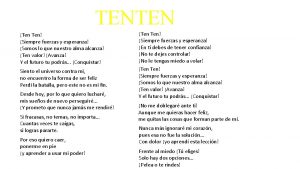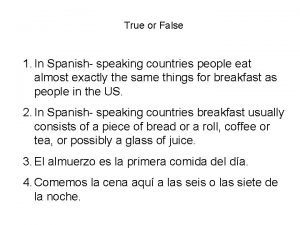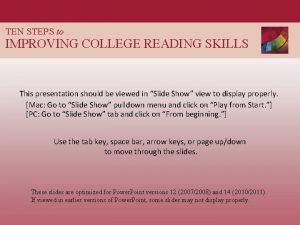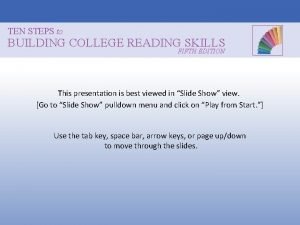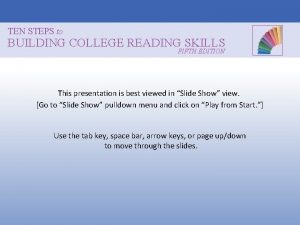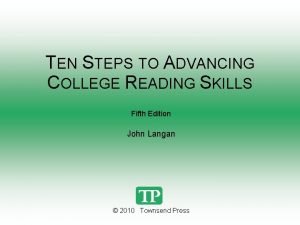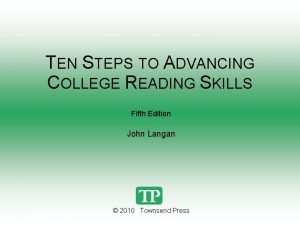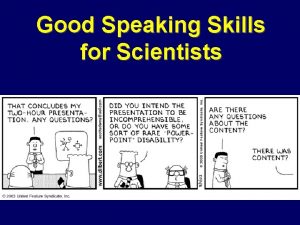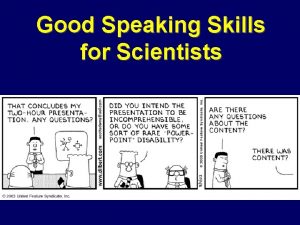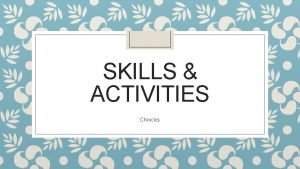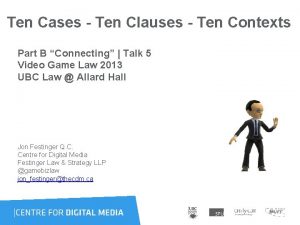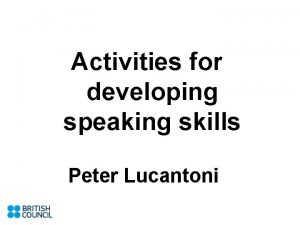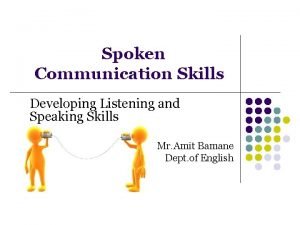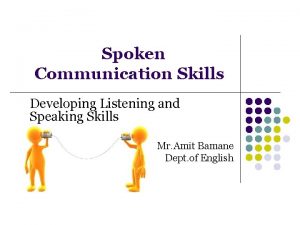Developing speaking skills Ten activities for developing speaking












- Slides: 12

Developing speaking skills Ten activities for developing speaking skills in beginners

1. What did you see? One student goes out to see what is happening outside. He comes back and tells the class what he saw. For example: - I saw a truck, two shops and a bicycle The rest of the children ask questions about it, one by one. For Example: - What was the truck carrying? - What was being sold in the shop?

2. Asking the explorers Send a group of five to six children to study a specific object or place near the school building. Eg. A tea stall, a broken bridge, or a nest. While the group is way exploring, tell the remaining children, details about the object or place. When the explorer group comes back they have to face questions from the class which they will have to answer.

3. Guess what I saw One child goes out and selects one of the many things that he sees. When he comes back he just says one sentence about the thing that he saw. For example: - The thing that I saw was brown The rest of the children ask questions to find out what he has in mind. For example: - Is it thin? - Is it big?

4. Comparing Make sets of similar looking things such as leaves and flowers of different trees, stones, pieces of paper cut in different sizes etc. Describe one of the things in a set and on the basis of the description the children guess which one you are thinking of. For example: I am thinking of a leaf that is smooth and long and has even edges. Soon the children take turns to describe

5. Analysing a picture Divide the class into groups and give a picture to each group with a set of questions. The group observes the picture and discusses the questions For example the children can be asked to : - Find things: - What is happening in the house? - Reason: - Why is the boy sad? - Project: (Relate to the picture by placing them in it) - What is the little girl thinking? - Predict: - What will the lion do to the mouse? - Relate: (Find parallels with their own lives) - Have you ever been angry with anyone? - What did it feel like and what did you do ?

6. Guessing the right picture You need a number of books with pictures for this. The children are paired and each pair is given a book. One child selects a picture from the book and describes it to the partner. The book is then given to the partner. Based on the description, the partner has to find the picture that fits the description. The roles are then reversed.

7. How did you make that? Teach children how to make things with paper, cloth or any other readily available material. Make elaborate comments on what you are doing as you demonstrate. For example: - Fold the paper into half. Then turn the corners inwards. The children can also make simple things on their own. They come and show the thing and tell the class how it has been made. Ask them to describe the process.

8. Acting out Choose some common actions that children see every day. For example: - Sweeping the floor, cutting vegetables, washing clothes, etc. Whisper to each child what action you have chosen for him or her. Then every child comes forward and performs the action. Others must guess what the action was. Groups of children can do collective action. For older children who can read, use slips of paper to tell them what to do

9. Making a story Any common experience can be turned into a story. Also, any common object can become the starting point of a narration. Collect common things like lids, pieces of cloth, leaves, stones, broken bangles etc. Make piles of five or six items and distribute among groups of five or six children. The children talk about the things in the pile and create a story in 15 -20 min.

10. Where do you live? Children live in two lines facing each other, one line has tellers, the other has listeners. Each teller has to explain to the listener the way o reach home. Listeners can ask any number of questions to understand better. For example: Teller: Go straight and then turn left. Listener: How far should I go straight before turning? Teller: Go till you reach a park. Then turn left.

Adapted from the handbook, “The child’s Language And The Teacher” by Krishna Kumar
 Fifty past nine
Fifty past nine Ten ten siempre fuerzas y esperanza
Ten ten siempre fuerzas y esperanza Ten ten program
Ten ten program True/false: there are ten spanish-speaking countries.
True/false: there are ten spanish-speaking countries. The statement of cash flows helps users
The statement of cash flows helps users Indoor and outdoor sports examples
Indoor and outdoor sports examples Support activities and primary activities
Support activities and primary activities Examples of primary activities
Examples of primary activities Ten steps to improving college reading skills
Ten steps to improving college reading skills Ten steps to building college reading skills
Ten steps to building college reading skills Ten steps to building college reading skills answer key
Ten steps to building college reading skills answer key Ten steps to advancing college reading skills
Ten steps to advancing college reading skills Ten steps to advancing college reading skills
Ten steps to advancing college reading skills

